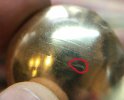purplepepper8
Member
Hi, quite often I get these little areas on my sheet metal that are kind of cracks but they dont run deep. While engraving, or in this case doming, they come apart like you see in the image. In this case you can also see the metal cracking along those horizontal lines. This metal is 18k yellow. Anyone know why this is happening? Thank you







